

Referral Forms For Professionals. CPAP Paid by OHIP - CPAP Clinic - Snoring Solutions & Sleep Apnea Blog. CPAP devices are costly, so it may not be affordable to all.
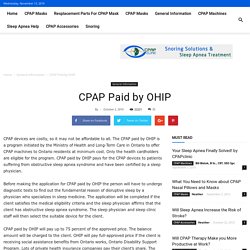
The CPAP paid by OHIP is a program initiated by the Ministry of Health and Long-Term Care in Ontario to offer CPAP machines to Ontario residents at minimum cost. Only the health cardholders are eligible for the program. CPAP paid by OHIP pays for the CPAP devices to patients suffering from obstructive sleep apnea syndrome and have been certified by a sleep physician. Before making the application for CPAP paid by OHIP the person will have to undergo diagnostic tests to find out the fundamental reason of disruptive sleep by a physician who specializes in sleep medicine.
The application will be completed if the client satisfies the medical eligibility criteria and the sleep physician affirms that the client has obstructive sleep apnea syndrome. CPAP paid by OHIP will pay up to 75 percent of the approved price. The clients can replace the equipment after five years if the equipment is no longer working and cannot be repaired. Nursing Homes - Canada's Long-Term Care Services. Applications to the following Nursing Homes and Long-Term Care Homes in Ontario can be obtained by contacting your Local Health Integration Network / Community Care Access Center.
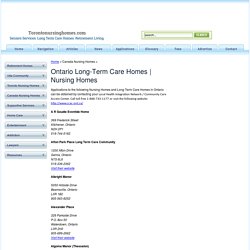
Call toll free 1-888-733-1177 or visit the following website: Ontario Central Forms Repository - Form Identification. You must download Adobe Acrobat Reader (version 10.0 or above) to view/print PDF forms.
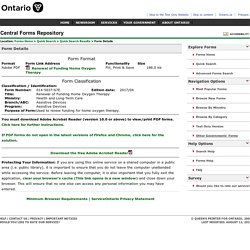
Click here for further instructions. If PDF forms do not open in the latest versions of Firefox and Chrome, click here for the solution. Protecting Your Information: If you are using this online service on a shared computer in a public area (i.e. public library), it is important to ensure that you do not leave the computer unattended while accessing the service. Before leaving the computer, it is also important that you fully exit the application, clear your browser's cache (This link opens in a new window) and close down your browser.
Ontario Central Forms Repository - Form Identification. You must download Adobe Acrobat Reader (version 10.0 or above) to view/print PDF forms.
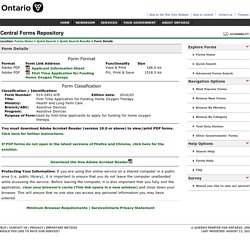
Click here for further instructions. If PDF forms do not open in the latest versions of Firefox and Chrome, click here for the solution. Protecting Your Information: If you are using this online service on a shared computer in a public area (i.e. public library), it is important to ensure that you do not leave the computer unattended while accessing the service. Before leaving the computer, it is also important that you fully exit the application, clear your browser's cache (This link opens in a new window) and close down your browser. This will ensure that no one else can access any personal information you may have entered. Product Manuals and Approved Prices- Assistive Devices Program - Health Care Professionals. Home oxygen therapy. Who qualifies To qualify, you must: be an Ontario resident have a valid Ontario health card meet medical eligibility criteria (e.g. hypoxemia at rest) for oxygen therapy We do not consider your income.
Community Care Access Centres - Health Services in Your Community. Local Health Integration Network (LHIN) Who We Are. If you, or someone you care about, needs health care services at home, at school or in the community, or if you are considering supported living programs or long-term care options, home and community care at the Toronto Central Local Health Integration Network can help.Toronto Central LHIN works with people of all ages to ensure they can make informed choices about their care, when and where they need it.

We also have useful information about local community support service agencies, and can link people to these providers to arrange services. You can explore your care and support options through our website, or contact us at 416-506-9888. Assistive Devices Program - Health Care Professionals. ADP Home Oxygen Application - CRTO. RRTs can independently authorize APD-funded home oxygen therapy applications Please note… If a Members’ employment or membership status has recently changed, they may no longer be eligible to authorize the ADP forms.
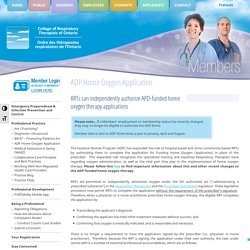
Member data is sent to ADP three times a year in January, April and August. The Assistive Devices Program (ADP) has expanded the role of hospital-based and some community-based RRTs by authorizing them to complete the Application for Funding Home Oxygen (application) in place of the prescriber. This expanded role recognizes the specialized training and expertise Respiratory Therapists have regarding oxygen administration, as well as the vital part they play in the implementation of home oxygen therapy. Assistive Devices Program - Health Care Professionals. Memorandum – Vendor Registration for Home Oxygen Therapy The Ministry has issued an invitation to establish a list of qualified vendors for home oxygen therapy.

Beginning April 1, 2017, only applicants who respond to the invitation and are approved by the Ministry will be: Local Health Integration Network. Local Health Integration Networks (LHINs) are the health authorities responsible for regional administration of public healthcare services in the province of Ontario, Canada.
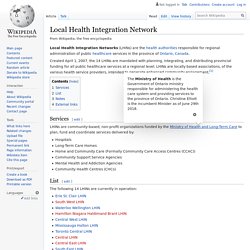
Created April 1, 2007, the 14 LHINs are mandated with planning, integrating, and distributing provincial funding for all public healthcare services at a regional level. LHINs are locally based associations, of the various health service providers, intended to generate enhanced community engagement.[1] Assistive Devices Program - Policies, Procedures and Administration Manuals. Assistive Devices Program. Overview Through the Assistive Devices Program (ADP), we help people with long-term physical disabilities pay for customized equipment, like wheelchairs and hearing aids.
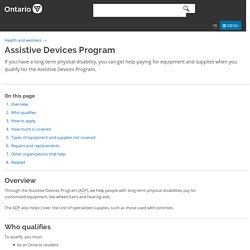
The ADP also helps cover the cost of specialized supplies, such as those used with ostomies. Health cards, eligibility and coverage. Home oxygen therapy. Works. Looking for work?
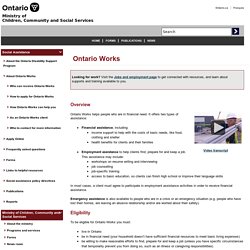
Visit the Jobs and employment page to get connected with resources, and learn about supports and training available to you. Overview Ontario Works helps people who are in financial need. It offers two types of assistance: Financial assistance, including: income support to help with the costs of basic needs, like food, clothing and shelter health benefits for clients and their families Employment assistance to help clients find, prepare for and keep a job. In most cases, a client must agree to participate in employment assistance activities in order to receive financial assistance.
Ontario Disability Support Program. Last resort income support program The ODSP is defined by provincial legislation, the ODSP Act, and its supporting regulations.[5] It is managed through policy directives.[6] Unlike Ontario Works, ODSP does not require recipients to undertake employment-related activities like job searching, or vocational training. This is determined through a subjective evaluation of four criteria[2] that are defined within the ODSP Act:[5] The disability is continuous or recurrent;It is expected to last for a year or more;The disability significantly limits their ability to work, look after themselves, or get out in the community; andIt has been verified by an approved health professional.
For recipients wishing to work, an optional component provides employment support funding, such as referral to a specialized employment counsellor.[7] Verification process[edit] The Disability Determination Package is used to collect information about the disability. Home oxygen therapy. Home oxygen manual.